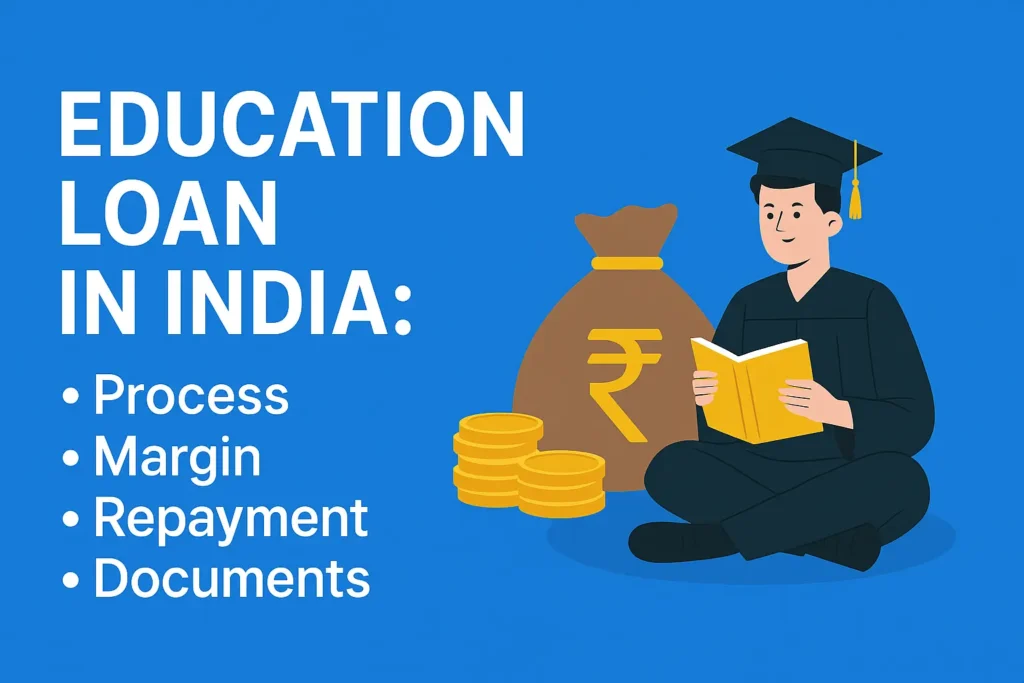
Getting a good education can be expensive. Many students in India dream of studying in top colleges or universities in India or abroad. But not every family can afford the full cost. That’s where an education loan helps. It supports your dream by covering expenses like tuition fees, hostel charges, books, and even living costs in some cases.
In this article, you’ll find clear answers to commonly searched questions about education loans. We’ve also added a few extra questions that students and parents often forget to ask, but are very important.
📘What is an Education Loan?
An education loan is a type of financial assistance provided by banks and NBFCs to help students pay for their academic studies. The loan can be used to cover tuition fees, examination fees, hostel expenses, travel costs (if studying abroad), books, and even living expenses. It is usually offered to students who have secured admission in recognized schools, colleges, or universities in India or abroad.
The loan has to be repaid after the completion of the course, often with a moratorium period during which no repayment is required.
🎯 Who is Eligible for an Education Loan?
Eligibility for education loans may vary slightly from bank to bank, but the common criteria include:
-
The student must be an Indian citizen.
-
Must have secured admission to a recognised college or university in India or abroad.
-
Admission is typically granted through an entrance test or a merit-based selection process.
-
A co-applicant (parent, guardian, or spouse) is usually required.
-
The co-applicant should have a stable income and good credit history.
Some banks may also have age limits or ask for a minimum academic performance in the 10th, 12th, or graduation.
🎓 Which Courses are Covered Under an Education Loan?
Most banks cover a wide range of academic courses under their education loan schemes. These include:
In India:
-
Graduation and post-graduation courses (BA, B.Com, B.Tech, MBA, etc.)
-
Professional courses (Engineering, Medical, Law, etc.)
-
Vocational training and skill development courses (approved by NSDC/State Skill Missions)
Abroad:
-
Degree and diploma courses from recognised institutions
-
MBA, MS, MBBS, and other job-oriented professional courses
-
Courses accredited by international universities or global bodies
If you are unsure whether your course is eligible, it’s best to ask your bank directly or check their official list.
📝 How to Apply for an Education Loan?
To apply for an education loan, you first need to secure admission to a college or university. Once you have received your admission letter, visit any nearby bank (such as SBI, Canara Bank, HDFC, etc.) or apply online through the Vidya Lakshmi Portal. You’ll be asked to fill out an application form, provide documents, and select the amount you need.
The bank will check your course, the university, the co-applicant’s income, and your academic performance before approving the loan. Once approved, the loan amount is paid directly to the college or university in most cases.
⏱️ How Much Time It Takes to Get Education Loan?
Usually, it takes 7 to 15 working days to get the loan sanctioned after you submit all required documents. This may vary depending on the bank, your course, and the amount of loan. If you apply through the Vidya Lakshmi Portal, it’s faster and easier.
Example:
Ravi submitted his loan documents to SBI on 1st July. The bank verified everything and sanctioned the loan on 12th July. Total time: 11 days.
💳 How to Repay Education Loan?
Repayment of education loan doesn’t start immediately. First, you get a moratorium period (explained below). After that, you must pay monthly EMIs (Equated Monthly Installments) to the bank.
You can repay through:
-
Bank auto-debit
-
Net banking
-
UPI or cash at branch
Tip: Start paying interest during your study to reduce the burden later.
Example:
Neha completed her BDS course in June 2024. Her EMI repayment of ₹6,500/month started in July 2025 after 1-year moratorium.
💰 What is Margin in Education Loan?
Margin means the part of your education cost that you have to pay from your side. The bank will not give a 100% loan. They keep a small margin that you must arrange.
-
For Indian education: 5% margin
-
For abroad education: 15% margin
Example:
For a ₹10 lakh course in India, the bank gives ₹9.5 lakh. You must pay ₹50,000 yourself.
⏳ What is Moratorium Period in Education Loan?
Moratorium is the “waiting period” after your course ends. During this period, you are not forced to pay EMIs. This gives you time to get a job.
-
It is usually Course duration + 6 to 12 months.
-
Interest may be charged during this time. (Called Simple Interest)
Example:
Sagar took a loan for a 3-year engineering course. He got a moratorium of 3 years + 12 months = 4 years. EMI started in the 5th year.
🔐 What is Collateral in Education Loan?
Collateral means any asset or security (like property, FD, insurance) that you give to the bank as a guarantee.
-
Loan up to ₹7.5 lakh: Usually no collateral needed
-
Loan above ₹7.5 lakh: Collateral may be required
Example:
Riya applied for ₹14 lakh loan for MS in the UK. Her father gave their house documents as collateral. This gave the bank extra security and helped in quick approval.
🏦 How to Apply Education Loan in Canara Bank?
You can apply in 2 ways:
-
Visit your nearest Canara Bank branch
-
Apply online through Vidya Lakshmi Portal
Process:
-
Fill application form
-
Submit documents
-
Wait for verification
-
Loan is sanctioned and disbursed
Example:
Megha applied through the portal and selected Canara Bank. She got a call in 2 days from her local branch to complete the loan process.
📲 How to Pay Education Loan?
Education loan is usually paid directly to the college or university. You do not receive cash in your account.
For repayment:
-
Set up ECS or auto-debit from your bank
-
Pay online via bank website
-
Use net banking, UPI or pay at branch
Example:
Deepak pays ₹7,000 EMI every month using auto-debit through his ICICI Bank savings account.
🏠 Does Education Loan Cover Living Expenses?
Yes! Education loans can also cover:
-
Hostel rent
-
Mess and food expenses
-
Travel cost (for abroad)
-
Laptop or study material
Example:
Aman is studying MBA in Australia. His ₹25 lakh education loan from Bank of Baroda also includes ₹5 lakh for living expenses and ₹1 lakh for laptop.
📊 Is CIBIL Score Required for Education Loan?
Yes. The CIBIL score of the co-applicant (parent or guardian) is checked by the bank. It shows how good the repayment history is.
How much CIBIL score required for education loan?
Banks prefer a score of 700 or above. A low score may lead to rejection or need for collateral.
Example:
Priya’s father had a CIBIL of 780. Her loan was approved in 7 days without any collateral.
🧾 What is Margin Money in an Education Loan?
It is the amount you pay from your pocket when the bank does not fund 100% cost.
Example:
Course cost = ₹12 lakh
Bank sanctions = ₹10.2 lakh
Margin money = ₹1.8 lakh to be paid by you before disbursement
📅 When to Repay Education Loan?
Repayment begins after moratorium ends. You get time to find a job and settle down before starting EMI.
Tip: You can repay interest-only or full EMI even during your course to reduce final burden.
Example:
Manoj started repaying ₹4,000 monthly interest during his 2-year course. So, when he got a job, his remaining EMI was only ₹6,500 instead of ₹9,000.
📝 How to Fill SBI Education Loan Form?
-
Visit Vidya Lakshmi Portal or SBI branch
-
Fill personal, course, and bank details
-
Choose branch and co-applicant
-
Upload documents
-
Submit and wait for approval
Example:
Komal filled SBI form online. She got a branch call within 3 days, visited, submitted her originals, and the loan got sanctioned in 8 working days.
📂 Which Documents Required for Education Loan?
-
Admission Letter from College/University
-
Course Fee Structure
-
Last Academic Marksheets (10th, 12th, Graduation)
-
Student’s Aadhaar and PAN
-
Co-applicant’s PAN, Aadhaar, income proof (Salary slip or ITR)
-
6-month Bank Statement of co-applicant
-
Passport (for abroad studies)
-
Property papers (if collateral needed)
-
Passport size photos
Example:
Rohit submitted all documents properly at HDFC Bank. Since his file was complete, his loan of ₹9 lakh was approved in 6 days.
❓ FAQs
Q1. Can I apply for loan without admission letter?
No. Admission confirmation is a must.
Q2. Can I repay before EMI starts?
Yes. You can repay interest or full loan early without penalty (in most banks).
Q3. Does education loan affect CIBIL score?
Yes. Regular EMI payment improves your score. Default can damage it.
Q4. Are there government subsidies on education loan?
Yes. CSIS scheme gives interest subsidy to economically weaker students.
✅ Conclusion
An education loan is a blessing for students who want to study but cannot afford the cost. Now that you know all the details — from application to repayment, margin to moratorium, documents to CIBIL score — you can confidently apply for the right loan. Compare banks, read terms carefully, and choose the right repayment plan.

